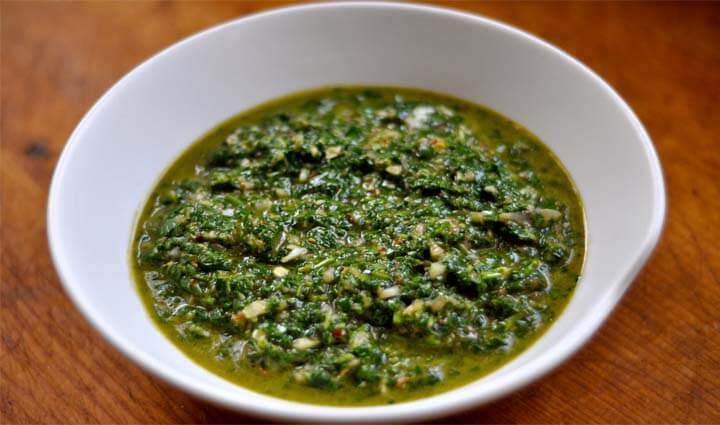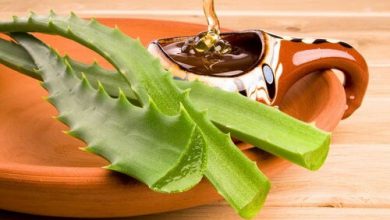Homemade Chimichurri Recipe

Chimichurri is a delicious sauce or typical dressing used in South American countries to accompany the famous barbecue or grill, mainly cooked in Argentina.
It also accompanies the popular empanadas from those regions and even salads. It generally consists of minced herbs and spices combined with oil and vinegar.
The main ingredients of chimichurri are parsley, olive oil and spicy. However, in its preparation, you can give preference to other elements, making it a very versatile and even customizable sauce.
Although many variations of the original recipe are applied in its preparation, it is recommended to keep the indicated proportions to obtain the traditional flavor. In this way, it will complement perfectly with the food that it accompanies.
Due to its popularity, commercial presentations of chimichurri are obtained and can already be purchased in many markets. However, the ideal is to prepare it at home with fresh ingredients and vary the quantities until the desired flavor is obtained.
Next, we will see a homemade chimichurri recipe that tries to preserve the original proportions of this unique sauce. In addition, we will briefly discover four versions of it and some brief notes on its origin. Take note!
The origin of the name chimichurri

In the gastronomic world there are three possible stories about the origin of this name, since the attribution of the sauce to any one in particular has not been fully demonstrated.
First version: a McCurry invention
Some point out that the chimichurri sauce was created by James McCurry, an Englishman popularly called Jimmy and that in the 19th century he marketed the product.
It is said that he created it by not having Worcestershire sauce available (English sauce). Apparently, people who were not native English speakers, when trying to pronounce his name, ended up saying “Yimi Churry”.
Second story: British prisoners
Another historical aspect ensures that the British, imprisoned by the Spanish in the South American colonies in the early nineteenth century, requested in prison that the sauce be passed to them for their meals.
They did it with the expressions “give-me-curry” or “che-my-curry”, which were later modified until they became “chimichurri”.
Or maybe it was the Basques …
Finally, it is commented that it could have had its origin in a Basque term reached America, “Tximitxurri”. This means ‘mixture’ or ‘jumble’ and alluded to a sauce made with ingredients and techniques that were repeated in all cases.
Homemade chimichurri recipe the traditional way
This recipe preserves the original ingredients and proportions of the exquisite sauce and is intended for approximately six people.

If you want more servings, the amounts of each ingredient can be proportionally increased.
Ingredients
- 3 bay leaves
- Juice of 1 lemon (100 mL).
- ½ teaspoon of salt (2 g).
- 1 cup of olive oil (200 mL).
- ½ cup of wine vinegar (100 mL).
- ½ teaspoon of pepper (2 g).
- 1 teaspoon of dried thyme (5 g).
- 3 cloves of garlic finely minced (15 g).
- 1 large tablespoon of oregano (10 g).
- 5 tablespoons of chopped parsley (40 g).
- ½ finely chopped red onion (20 g).
- 1 teaspoon of sweet paprika powder (5 g).
Elaboration
- In the first place, we must in a mortar the oregano, the parsley, the garlic and the crumbled bay leaf.
- After this, we will mix the onion and the rest of the spices (thyme, pepper and sweet paprika) in a container.
- Then, to prepare the base of the sauce, we have to emulsify the oil, vinegar, lemon and salt.
- Once this is done, we will add the base of the sauce to the mixture and stir.
- When it is made, we will pack it in a glass jar with a lid.
- To finish, we must marinate the sauce in the least cold part of the fridge for a couple of days.
After starting to use , this sauce can be consumed in a time of 3 months if it is refrigerated.
Variations of the original chimichurri recipe
Variations of this homemade chimichurri recipe can be obtained if various ingredients are added or others are substituted. For example, if you substitute a little more garlic for the red onion, you get a garlic chimichurri.

For its part, a tomato chimichurri is obtained if, to the traditional mixture, about 200 grams of dried tomato are added and you wait long enough for it to hydrate.
Lastly, we can also get a coriander chimichurri. To do this, we will substitute the parsley for this herb in the same proportion. The result will be a very aromatic sauce, ideal to accompany many preparations.
With this easy-to-make homemade chimichurri recipe, there’s no reason to buy the sauce at the grocery store. It has the advantage that its fresh ingredients provide quality and a longer life, without preservatives or chemical additives. Do not hesitate to prepare it!









